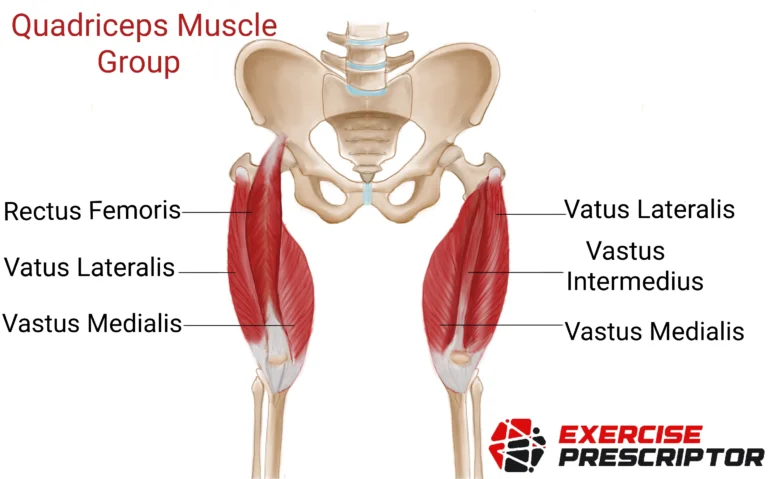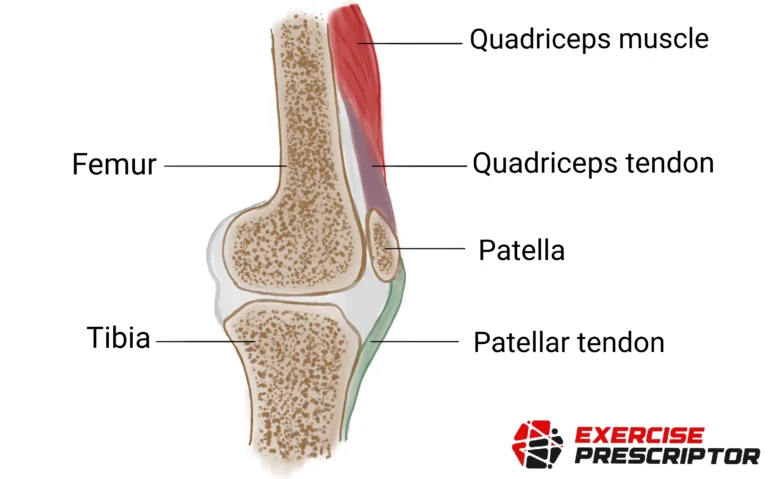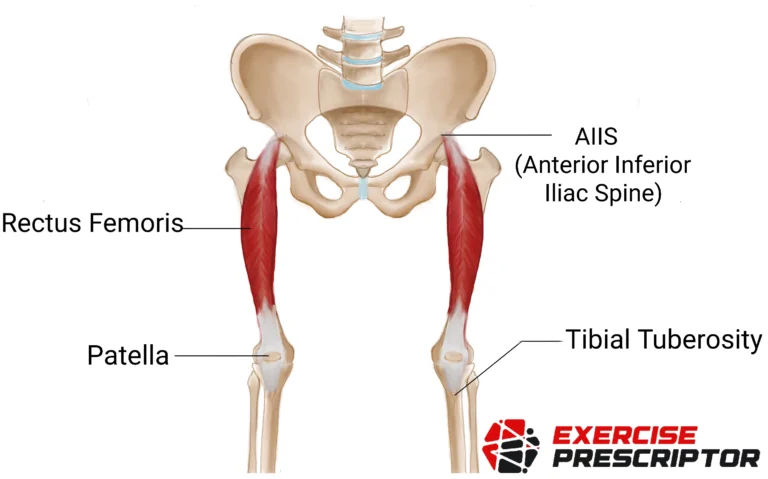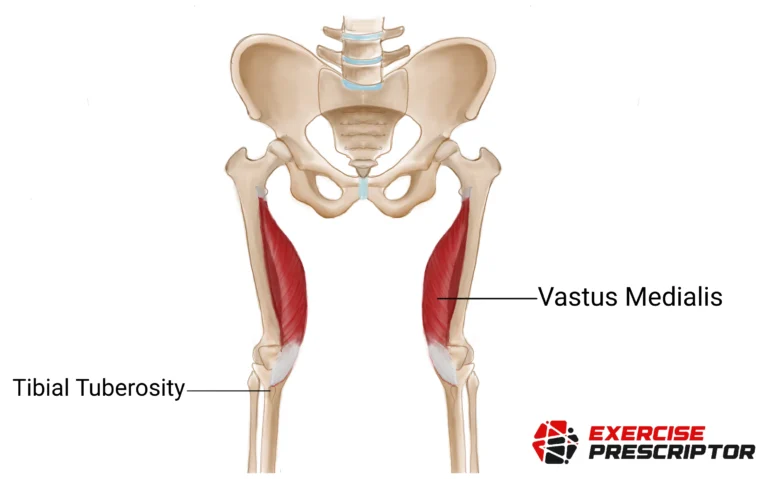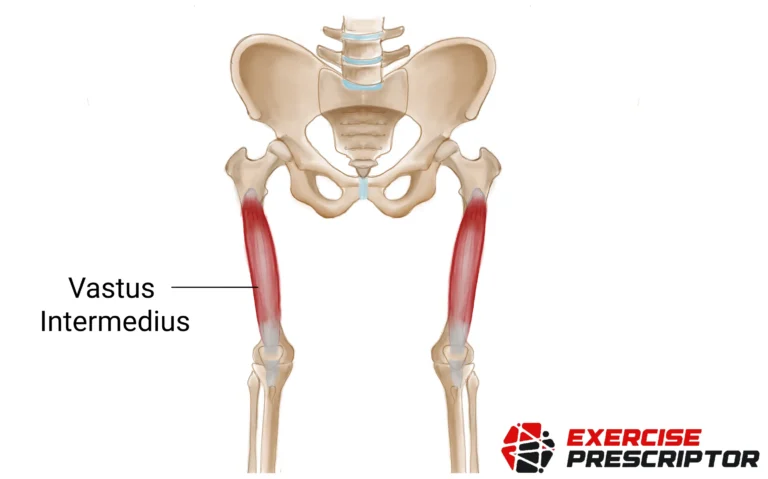What are the quad muscles made of?
Quadriceps muscles are made of
- Skeletal muscle fibers, which are responsible for contraction and force production,
- Connective tissues that provide structural integrity,
- Tendons that connect the muscle to the bones (quadriceps tendon and patellar tendon).
Types of Muscle fibers in quads:
The quadriceps muscles contain a mix of all three types of skeletal muscle fibers: slow oxidative (Type I), fast oxidative glycolytic (Type IIa), and fast glycolytic (Type IIx) fibers. However, the proportion of these fibers can vary depending on genetics, as well as the fitness level and the demands of everyday activities.
The muscle fiber proportion can be varied with exercise training and will be based on the type and intensity of training, leading to shifts in muscle fiber composition over time. Endurance activities: More type I fibers, Power and strength activities: more type II fibers.
For example, endurance athletes like marathon runners, cyclists, cross-country runners, and triathletes have more type I muscle fibers in the quadriceps.
On the other hand, weight lifters, power lifters, and sprinters can have more type II fibers in their quadriceps. So, basically, muscle fiber adaptation will depend on the demand we place on the muscle.
Function
All four muscles together work primarily on the knee joint. Rectus femoris is the only muscle in the group that produces movements in both the hip and knee joints.
Concentric (shortening) action:
Standard mover action:(distal attachment moving towards proximal)
- All four muscles extend the leg at the knee joint (like in sitting on a chair and raising the leg towards the ceiling).
- Additionally, the Rectus femoris flexes the thigh at the hip joint. (Marching)
- Since the rectus femoris is a two-joint muscle, it may not be able to extend the leg at the knee joint effectively, especially when the hip is flexed. This is because of the active insufficiency of the rectus femoris.
Reverse mover action:(proximal attachment moving towards distal)
- All four muscles extend the thigh at the knee joint (standing up from a seated position).
- Additionally, the Rectus femoris produces an anterior pelvic tilt at the hip joint.
The reverse action of the quadriceps is very important in movements like standing up from a chair. In this case, the quadriceps action is not just straightening the knee; they also help pull the thigh and lift the whole body into an upright position. This is why the quadriceps muscles are strong and large.
Eccentric (lengthening) action:
- All four muscles control and slow down the flexion of the knee joint.
- Additionally, the rectus femoris will control hip extension and posterior pelvic tilt.
Isometric function:
The quadriceps muscles work together isometrically to stabilize the knee joint during various lower limb activities. This stabilization is musch essential as the knee jont is a major weight-bearing joint, essential for everyday movements such as standing, walking, running, and more
Axis and plane:
The muscle fibers of the quadriceps muscles are present anterior to the knee joint, so their contraction causes movement of the knee joint in the sagittal plane around the frontal axis (flexion and extension).
Pennation and force production:
Pennation is the arrangement of muscle fibers at an angle to the tendon’s line of action. This arrangement accommodates an increased number of muscle fibers within a given cross-sectional area, resulting in increased force production.
However, pennation (the angulation of muscle fibers) reduces the overall shortening ability of the muscle, resulting in a reduced range of motion compared to parallel muscles.
Pennations of the quadriceps muscle group:
- Rectus femoris- bipennate muscle,
- Vastus lateralis and vastus medialis- unipennate muscles
- Vastus intermedius- bipennate (slight pennation)
This pennation enhances the force production ability, significantly contributing to the role of the quadriceps group in explosive movements, such as sprinting, running, and jumping.
What is the purpose of your quadriceps muscle?
The quadriceps muscle plays a vital role in both everyday activities and high-level athletic performance. The quadriceps are essential for even simple movements that involve knee extension (straightening the knee), like getting up from a chair, walking, running, climbing up and down the stairs, kicking, etc.(all these involve concentric contraction of the quads).
In addition, it is essential for activities that need controlled knee flexion, like squatting, sitting on a chair, climbing down the stairs, landing from a jump, etc. (where eccentric contraction of the quads occurs)
Quadriceps also help in shock absorption and stabilizing the knee joint, which is one of the body’s major weight-bearing joints.
Stabilization of the patella:
The quadriceps muscle group attaches to the patella and tibial tuberosity through the quadriceps tendon and patellar tendon, respectively. This attachment helps in stabilizing the patellofemoral and tibiofemoral joints, contributing to the dynamic stability of the knee joint.
Shock absorption:
During activities like walking, running, and jumping, the quadriceps muscles will help in shock absorption.
Especially during the landing phase or while the foot strikes the ground, eccentric contraction of the quadriceps muscles absorbs the impact and reduces excessive loading of the knee joint.
Strengthening the quadriceps muscles is crucial for lower limb functions, knee joint integrity, overall strength and mobility, and also to prevent knee joint injuries.
Common injuries:
What are the common injuries that affect the quadriceps?
Some of the most common quadriceps-related injuries include:
- Quadriceps strain
- Quadriceps tendinopathy
- Quadriceps tendon rupture
- Patellar tendinopathy (jumper’s knee)
- Patellar tendon rupture
Myositis Ossificans
Quadriceps Strain (Muscle Pull):
A quadriceps strain is an injury that involves overstretching or tearing of the quadriceps muscle fibers, usually during activities involving sudden forceful contraction of the quadriceps.
Cause:
Sudden acceleration, deceleration, or explosive movements like sprinting, jumping, or kicking.
Symptoms:
Sharp pain, swelling, muscle tightness, reduced strength, reduced range of motion, and possible bruising.
Quadriceps muscle strain can range from mild overstretch to severe muscle stretch:
- Grade I: Mild overstretch, minimal fiber damage
- Grade II: Partial muscle tear
- Grade III: Complete muscle rupture
Quadriceps Tendinopathy:
Quadriceps tendinopathy is a chronic overuse injury of the quadriceps tendon, which connects the quadriceps muscle to the superior pole of the patella. It is common in athletes involved in jumping, running, and squatting activities.
Cause:
Overuse injury due to repetitive loading (e.g., running, jumping, squatting).
Symptoms:
Gradual onset of pain just above the patella, stiffness (especially in the morning or after rest), and tenderness at the superior pole of the patella.
Quadriceps Tendon Rupture:
It is a tendon injury that involves partial or complete rupture of the quadriceps tendon.
Cause:
Sudden, forceful eccentric contraction (e.g., missing out a step, landing from a jump). Existing tendinopathy can be a predisposing factor.
Symptoms:
Severe pain, popping or tearing sensation, swelling, bruising, inability to straighten the knee actively, loss of function, visible deformity, palpable gap above the patella, the patella appears a little low.
Complete tendon rupture often requires immediate surgical repair, whereas a partial tear can be treated conservatively with adequate rest and appropriate physiotherapy.
Myositis Ossificans:
It is a condition that involves abnormal bone formation inside a muscle or soft tissue, usually following trauma. It often occurs in the rectus femoris of the quadriceps muscle group.
Cause:
It can occur following a direct trauma or repeated contusions, poorly managed muscle strains or hematomas, early aggressive stretching or massage after muscle injury. It can also occur in neurologically impaired patients.
Symptoms:
Pain, swelling, stiffness, palpable hard lump, and sometimes reduced ROM.
Avoiding deep massage, heat, or aggressive stretching early on muscle injury is the preliminary prevention.
Quadriceps Contusion (Bruise)
It is a bruise or hematoma (bleeding) within the quadriceps muscle caused by a direct blow or impact. It is a common injury in contact sports such as football, rugby, or hockey.
Cause:
Direct trauma to the front of the thigh leading to bleeding within the muscle and soft tissues.
Symptoms:
Pain and tenderness at the site of impact, Swelling and visible bruising (ecchymosis), Muscle stiffness and pain during knee flexion, limping.
Patellar Tendinopathy (Jumper’s Knee):
It is a chronic overuse injury of the patellar tendon, usually occurring at its proximal attachment (inferior pole of the patella). It is commonly seen in sports that involve more jumping and sprinting, such as basketball, volleyball, and track events.
Cause:
Repetitive Overuse or stress from jumping, landing, running, or squatting.
Symptoms:
Localized pain at the below patella (inferior pole), which gets worse with activity. Stiffness after rest, especially in the morning or after long periods of sitting. Tenderness on palpation over the patellar tendon
Patellar Tendon Rupture:
It involves a partial or complete rupture of the patellar tendon
Cause:
Sudden, forceful contraction of the quadriceps (e.g., landing from a jump), common in individuals with prior tendinopathy or systemic diseases (e.g., diabetes, rheumatoid arthritis)
Symptoms:
Sudden pain and a “popping” sound, Inability to actively straighten the knee, Visible gap below the patella. The patella may be pulled upward (patella alta)
Severe complete rupture of the patellar tendon requires immediate surgical repair, whereas a partial tear can be treated conservatively with adequate rest and appropriate physiotherapy.
Other Related Conditions
- Delayed Onset Muscle Soreness (DOMS) –it cannot be considered an injury. However, it is the soreness that is common after eccentric contraction of the quadriceps, either by eccentric exercises (squats) or by unusual activity (downhill running).
- Referred pain from the hip or lumbar spine – sometimes mistaken for a quadriceps injury.
What are the symptoms of quad muscle injuries?
Symptoms of quadriceps injury depend on the type and severity of injury.
Certain symptoms are common with quadriceps injuries:
- Pain and tenderness in the front of the thigh
- Swelling in acute strains and contusions
- Muscle tightness attributed to protective spasm
- Reduced muscle strength and range of motion of the knee joint, especially knee extension.
- Limping or difficulty in performing day-to-day activities that involve straightening the knee joint.
- Visible deformity in the case of tendon or muscle ruptures.
What are the risk factors for quad muscle injuries?
Identifying the risk factors for quadriceps injury can help formulate strategies for the prevention of injury and recurrence. Some of the risk factors include:
Inadequate warm-up:
Warm-up is essential for preparing the joints, muscles for an activity. It enhances neuromuscular coordination, thereby enhancing movement efficiency. Inadequate warm-up can make the muscle contract without preparation, reduced force generation, leading to injury to the muscle.
Overloading:
A sudden increase in training volume or repetitive overloading more than the muscle’s capacity can result in muscle injury.
Demand > Capacity→ injury
Poor flexibility:
Tight quadriceps can increase the risk of injury as this reduces the muscle’s ability to lengthen under tension.
Previous injury
A history of quadriceps injury without proper rehabilitation and recovery can be a risk for reinjury.
Inadequate recovery:
Overtraining the quadriceps muscle without allowing for recovery, which is crucial for adaptation, is a significant risk for injury. Time for recovery also includes adequate sleep, nutrition, and hydration.
Biomechanical errors:
Poor techniques put the person at risk of injury.
- Age: As age advances, the tissue elasticity diminishes, increasing the susceptibility to injury.
- Other risk factors include hard & uneven training surfaces, improper footwear.
What happens if quads are weak?
If the quadriceps are weak, that will significantly affect the activities of daily life as well as athletic performance. It is an important muscle group that has a crucial role in lower limb functions.
Knee or patellar instability:
Quadriceps and patellar tendons help in stabilizing the knee joint anteriorly, especially during walking, running, and stair climbing. If the quads are weak, it can lead to buckling of the knee or a feeling of instability.
Quadriceps and patellar tendons attach to the patella, keeping it in place and helping in proper patellar tracking. Poor control of the patella can result in patellofemoral pain syndrome. Increased load on ligaments and cartilage may accelerate degeneration or arthritis.
Difficulty in functional movements:
Weak quads can cause difficulty, discomfort, or pain in sitting down, standing up from a chair, climbing or descending stairs, squatting, and walking.
Poor athletic performance:
Weak quads impair force production, resulting in reduced power and performance in sports activities that involve jumping, sprinting, or kicking. Poor endurance in the quadriceps muscle will also reduce performance.
Quads’ eccentric strength is crucial for smooth and controlled landing and deceleration. Weakness may cause excessive joint loading, increasing injury risk. Slower reaction time can significantly increase injury risk.
Increased risk of fall:
Especially in elderly individuals, reduced quadriceps muscle strength will have a greater impact, and it reduces movement independence by increasing the risk of falls.
Does walking strengthen quads?
Yes, walking can strengthen the quadriceps muscle, but only to a limited extent. Walking is indeed helpful in activating and maintaining basic strength in the quadriceps, especially in sedentary individuals or older adults.
However, if we intend to strengthen the quadriceps muscles for athletic performance, enhanced fitness, or rehabilitation.
Walking does activate the Quads:
While walking, as the heel strikes the ground, the quadriceps are activated. During the midstance phase, when a single limb bears the whole body weight as the other limb is about to strike the ground, the quads stabilize the knee joint of the weight-bearing limb. They concentrically contract to extend the knee during the push-off phase. This activation helps maintain muscle tone and endurance.
For whom is walking helpful?
- Older adults or deconditioned individuals: Walking can prevent muscle atrophy, improve functional mobility, and preserve joint health.
- Post-injury rehab: As a gentle reintroduction to weight-bearing movement.
- Sedentary individuals: Walking can help re-engage dormant muscles.
Quadriceps strengthening:
Walking is an activity of very low load, so it won’t significantly increase muscle strength or size. Adequate strength gains, especially in athletes or patients recovering from injury, can be achieved by Quadriceps strengthening exercises and progressing them gradually.
Some of those exercises include:
- Resistance training: Leg press, knee extension machine.
- Isometrics: Wall sits, static quad holds.
- Eccentric training: Decline squats, slow lowering movements
